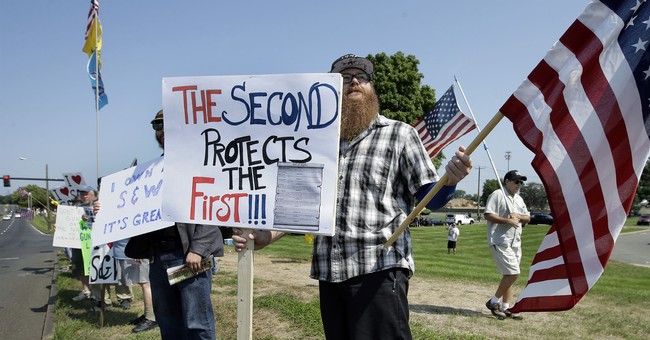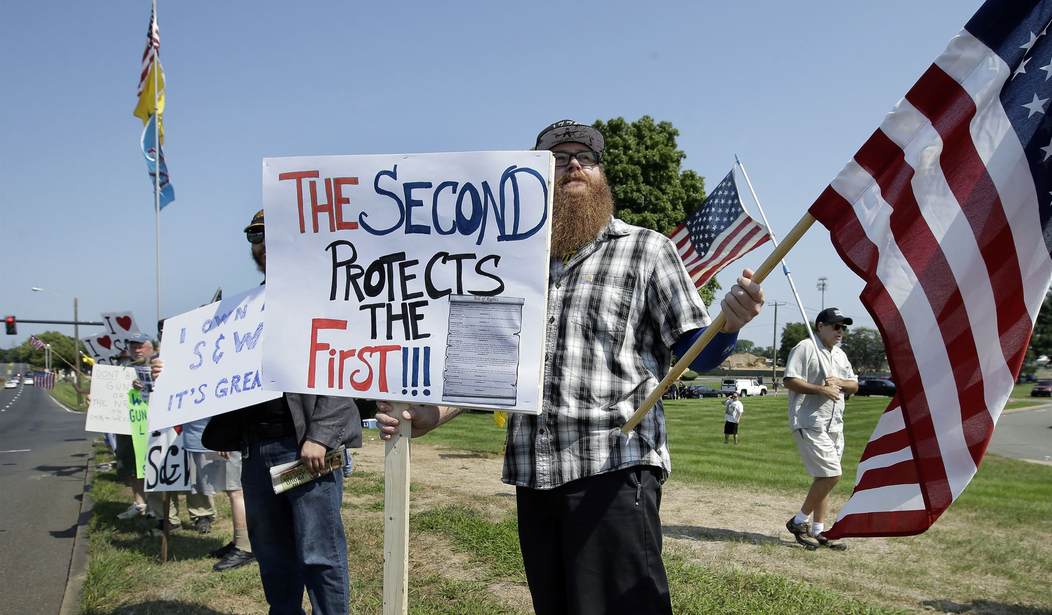
This stuff does not happen by accident, as there sometimes is a design and purpose behind the crafting of legal arguments in an appellate decision. Today’s decision from the 9th Circuit Court of Appeals invalidating a California law banning “large capacity magazines” (LCMs) — magazines that hold more than 10 rounds of ammunition — was crafted by the author for the purpose of increase the likelihood that the Supreme Court will take the case up and issue some clarifying principles with regard to limitations on Second Amendment rights imposed by state legislatures.
Before we get to the decision, let’s introduce the players. The decision came in the matter of Duncan v. Bacerra, and the 9th Circuit panel who heard the case was Judge Consuelo Callahan, Judge Barbara Lynn, and Judge Kenneth Lee.
Judge Callahan was appointed to the 9th Circuit Appeals Court in 2003 by Pres. Bush 43. She was thought to be a leading candidate to replace Justice Sandra Day O’Connor on the Supreme Court, and would have been the first Hispanic Female on the Court.
Judge Lynn is currently the Chief Judge of the District Court for the Northern District of Texas, and sat on the 9th Circuit panel “by designation”. The 9th Circuit does this with some regularity because of the huge number of cases filed in that Court. Judge Lynn was appointed to the District Court in Dallas by Pres. Clinton in 1999.
Judge Lee was appointed to the 9th Circuit Court in 2019 by Pres. Trump. Judge Lee’s appointment was controversial due to writings by him published in the Cornell Review, a conservative/libertarian campus paper. Lee graduated with Honors from Harvard Law School, worked for a major New York firm, and later for the Senate Judiciary Committee. His nomination was opposed by both Sen. Diane Feinstein and Sen. Kamala Harris. He passed through the Judiciary Committee on a party line 10-8 vote, and was confirmed by the Senate 50-45.
Judge Lee wrote the opinion of the Court, and showed in that opinion why he was opposed and feared by Senate Democrats.
Judge Lee’s opinion seems crafted to force the Supreme Court to take up the matter as he goes a different direction on a key issue than have the four other Circuit Courts of Appeal to address the issue — whether a statute limiting the sale and possession of LCMs should be reviewed with “strict scrutiny” or a less demanding level of judicial deference to state legislators?
The statue in question is California Penal Code Sec. 32310, which in 2016 was amended to enact a complete ban on possession of LCMs. But Judge Lee noted that the statute had not always been so broad.
“As originally enacted in 2000, it prohibited the manufacture, importation, and sale of LCMs… Ten years later, California declared unlawfully possessed LCMs to be a nuisance subject to confiscation and destruction…. And in 2013, California further extended the law to prohibit the purchase and receipt of LCMs…. the law still allowed Californians who lawfully bought LCMs well before section 32310’s enactment to keep them. So, in 2016, the California legislature … prohibited possession of LCMs outright after July 1, 2017.”
Judge Lee next turned to the analysis used by the Ninth Circuit in determining whether a state statute “burdens” a fundamental constitutional right.
To determine whether the law burdens protected conduct, this court appears to ask four questions. First, as a threshold matter, we determine whether the law regulates “arms” for purposes of the Second Amendment…. Second, we ask whether the law regulates an arm that is both dangerous and unusual…. If the regulated arm is both dangerous and unusual, then the regulation does not burden protected conduct and the inquiry ends. Third, we assess whether the regulation is longstanding and thus presumptively lawful…. and fourth, we inquire whether there is any persuasive historical evidence in the record showing that the regulation affects rights that fall outside the scope of the Second Amendment…. If either of these latter questions is found in the affirmative, the law does not burden protected conduct and the inquiry ends.
If there is a burden on a protected constitutional right, the Court next turns to whether the law should be subjected to judicial “strict scrutiny” — is it the type of burden that is recognized as allowable depending on the nature of the right and the severity of the burden imposed.
If a court finds that a regulation burdens protected conduct, then it must proceed to the second prong of analysis and determine the appropriate level of constitutional scrutiny… This, in turn, requires the court to ask two more questions. First, we ask how “close” the challenged law comes to the core right of law-abiding citizens to defend hearth and home… And second, we analyze whether the law imposes substantial burdens on the core right. If a challenged law does not strike at the core Second Amendment right or substantially burden that right, then intermediate scrutiny applies… Only where both questions are answered in the affirmative will strict scrutiny apply.
The question of the “level of scrutiny to apply” is where these cases are decided. Few state statutes will survive “strict scrutiny” analysis, whereas many more laws will survive “intermediate scrutiny” analysis. The level applied to laws which infringe on the Second Amendment — how much of a burden on that right does the law impose — is for the judge to decide, and generally decides he outcome of the case. Judge Lee found the nature of the burden — a complete ban of HCMs under threat of a jail sentence — did “strike at the core of Second Amendment right” and did “substantially burden that right,” thus “strict scrutiny” of the statute was required.
But Judge Lee then slips in the dagger once he’s got the gun control proponents on their knees. He recounts the history of violence against disfavored minority groups as evidence of the need for citizens to have access to devices that allow them to defend “hearth and home” — namely the history of violence against African-Americans by the KKK and other racist groups. But it is not just African-Americans who, as people of color, need to be able to defend themselves:
Our country’s history has shown that communities of color have a particularly compelling interest in exercising their Second Amendment rights. The Second Amendment provides one last line of defense for people of color when the state cannot — or will not — step in to protect them. This remains true today across all communities of color. For example, amid the COVID-19 pandemic, Asian-Americans have become the target of physical attacks by those who scapegoat them for the virus…. In response to these assaults and threats to their lives, Asian-Americans have begun arming themselves.
Judge Lee was born in Seoul, South Korea, and came to the US with his parents at age 4.
California Penal Code section 32310 substantially burdens core Second Amendment rights. It bans LCMs that come standard in guns commonly used for self-defense in the home. Its scope is broad and indiscriminate. And it provides no meaningful exceptions for law-abiding citizens. Strict scrutiny applies under the reasoning of our prior decisions: “A law that implicates the core of the Second Amendment right and severely burdens that right warrants strict scrutiny.”
That is where Judge Lee effectively decides the case, as few if any statutes survive a “strict scrutiny” challenges because a core issue of fundamental liberty is involved. Judge Lee finds that the California law cannot survived:
Strict scrutiny is the “most rigorous and exacting standard of constitutional review,” and requires that a state law be “narrowly tailored to achieve a compelling interest.” “[I]f there are other, reasonable ways to achieve [a compelling state purpose] with a lesser burden on constitutionally protected activity, a State may not choose the way of greater interference.
We understand the purpose in passing this law. But even the laudable goal of reducing gun violence must comply with the Constitution. California’s near-categorical ban of LCMs infringes on the fundamental right to self-defense. It criminalizes the possession of half of all magazines in America today. It makes unlawful magazines that are commonly used in handguns by lawabiding citizens for self-defense. And it substantially burdens the core right of self-defense guaranteed to the people under the Second Amendment. It cannot stand.
The vote in the case was 2-1, with Judge Lynn dissenting. The points raised by her are the reasons why I believe Judge Lee wrote an opinion intended to draw Supreme Court notice. She concludes that because the ban on LCMs does not constitute a ban on all firearms — magazines with a capacity of under 10 rounds are still lawful — the appropriate standard of review should be “intermediate scrutiny,” and not “strict scrutiny.
I cannot agree that § 32310 is a substantial burden on that right. Section 32310 “restricts possession of only a subset of magazines that are over a certain capacity. It does not restrict the possession of magazines in general such that it would render any lawfully possessed firearms inoperable, nor does it restrict the number of magazines that an individual may possess.”… Just as “[a] ban on the sale of certain types of ammunition does not prevent the use of handguns or other weapons in self-defense,” and “leaves open alternative channels for self-defense in the home” …. § 32310 does not place a substantial burden on core Second Amendment rights because it does not prevent the use of handguns or other weapons in self-defense.
Under an “Intermediate Scrutiny” standard, Judge Lynn argues that the statute does not violate the Second Amendment.
Because I would find that § 32310 does not substantially burden the core Second Amendment right, I would apply intermediate scrutiny. This conclusion is consistent with that reached by all of our sister Circuits that chose a level of scrutiny in LCM cases.
Judge Lynn then goes on to describe the facts in decisions on LCMs in four other Circuit Courts of Appeal, pointing out that all of them used “Intermediate Scrutiny” as their standard of review.
What Judge Lee has done with his opinion is to create a “split” in the Circuits on a critical issue of constitutional jurisprudence — the ability of states to regulate the sale of firearms. The 9 states covered by the 9th Circuit have a combined population of 61 million people. That’s nearly twice the size of the next largest Circuit Court — with is the 11th Circuit with 33 million people.
With Judge Lee’s opinion, nearly one-fifth of the country will have a different legal interpretation of its Second Amendment rights than other large parts of the country — a core constitutional issue.
The Supreme Court has evaded most Second Amendment cases in recent years by refusing to take them up for review Judge Lee might have found an issue that SCOTUS is forced to take up and decide.














Join the conversation as a VIP Member